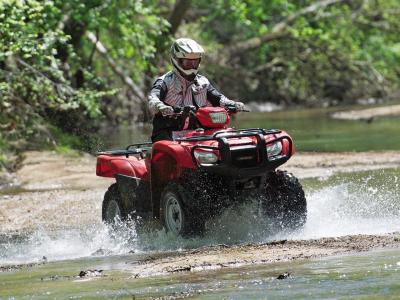 Honda unveiled the fifth generation Honda Foreman ATV at its South Carolina production facility in Florence. The redesigned 4x4 was the first machine fully developed/produced – from concept to production – entirely in the United States. We took part in the quad’s initial production, or “Line Off” ceremony, at HSC prior to riding it at Carolina Adventure World a day later.
Honda unveiled the fifth generation Honda Foreman ATV at its South Carolina production facility in Florence. The redesigned 4x4 was the first machine fully developed/produced – from concept to production – entirely in the United States. We took part in the quad’s initial production, or “Line Off” ceremony, at HSC prior to riding it at Carolina Adventure World a day later.
The 2012 model was built with the average Foreman customer in mind, according to American Honda’s Steve Markofski. He explained that “the average buyer” puts a priority on the work capability of a machine, sees durability as the primary need, but still likes to have a good time. This “person” is roughly 47 years old, stands 6 foot tall and tips the scale at 200 pounds. He needs a machine that’s dependable and accommodating.
2012 Key Updates
Markofski said the new Foreman’s redesign basically began six months after the release of the previous generation model (gen. four) and was influenced by both dealer and customer feedback. Let’s take a more in-depth look at this ATV.
Engine: Improved power and torque
EFI added
Suspension: Larger shocks. Rear end went from a dual-shock setup to a swingarm with single shock design.
Front disc brakes enhanced
Maxxis tires
Size & Ergos: A tad longer, wider, taller and heavier than last year’s model. More spacious!
LCD display
Appearance: Bold enough to catch your eye, but conservative enough to not alienate the Honda loyalists.
Engine
Although the new Foreman’s engine displacement (475cc) and bore and stroke remain the same, the machine features essentially an all-new engine. Sitting longitudinally in the steel chassis, the powerplant is now liquid-cooled and fed via electronic fuel injection and a 36mm throttle body. It also has new cases and cylinder head, increased compression, and all the changes resulted in 10 percent more power.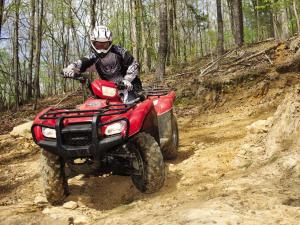
We found the single-cylinder four-stroke much more fun on the bottom-end of the powerband. Though quick to expire, first and second gears were snappy and produced respectable acceleration. Third gear offered a good balance between torque and power and we rode in this gear the majority of the time. “Third gear on the machine is definitely the sweet spot,” explained Markofski. “You can keep it in third gear for almost every situation. It’s where ride ability begins!”
The Foreman does not feature a low range like some of its competitors, but Honda’s OK with that explained Markofski. “First gear is not really a trail riding gear. It’s a working gear and is for pulling and severe climbing. Second, for that matter, is short lived and those are our two ‘working’ gears.”
At the upper end of the powerband, the Foreman was pleasing but not exhilarating. We dialed in both of these gears on the riding area’s open roads during our testing session. In two-wheel-drive around the sweeping gravel turns, the Foreman produced its sportiest ride of the day and wasn’t afraid to slide its rear around the bend. Markofski described fourth gear as mellow and fifth gear as giving off the sensation of overdrive. We’d have to agree. Wide-open OHV roads might be the only place where you’d need (or want) more top-end power. For the Foreman’s intended buyer (remember that 47-year-old?) fifth-gear pinned it plenty already.
Suspension
The Foreman wears an all-new suspension that Honda says is more comfortable and more capable of work and play. Both the front and rear shocks are larger and now feature five-way adjustments for preload. Travel was moderately increased on the rear to 6.9 inches. Markofski said the Foreman offers a softer ride during the first two inches of the initial stroke. He described the riding feel as somewhat like floating at that point of stroke. “We wanted to go for more comfort for the sit-down rider while he’s traveling for recreating or working” added Markofski.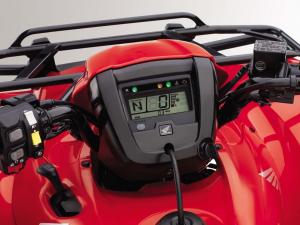
The Foreman’s most significant suspension change happened at the rear of the machine. The old twin-shock rear end was replaced by a box-section swingarm and a single shock. The new swingarm is three inches wider and the rear axle sits inside a housing for improved durability. The new rear shock is much larger, holds more oil and features a beefier spring. “We were able to accomplish two things: a softer ride in the rear and less sag under a load than with the twin-shock setup.” declared Markofski.
We’d give the new suspension a passing grade and we pushed it harder than the average buyer likely will. That’s probably why we noticed a bit of rear wheel lift when cornering aggressively. For example: when we rode the Foreman hard into a sharper left-hand turn, the inside left rear wheel would lift off the ground. We’re not sure if the body lean was a result of the rear setup, the front shocks, the new Maxxis tires, or a combination of all three. Regardless, the four-wheeler remained controllable at all times and handling is still predictable and fun.
Handling is also improved on this model when it’s outfitted with Electronic Power Steering (EPS). The system works well to smooth rough hits and to produce all-day comfort. Honda says EPS comes into play both for work and recreation. Simple chores around the farm can be made simpler (operating a wand sprayer for example) with the ease and comfort that comes with power steering.
This Foreman wears all-new Maxxis tires that are exclusive to Honda. They are the same size (25 x 8-12, front and 25 x 10-12, rear) as the Dunlop rubbers, but have a new tread pattern. This tire choice has everything to do with traction as it does price control and workload capacities and capabilities. The tire, which is mounted to aluminum wheels, performed well for us in the rocks, hard-pack, rutted trails and the occasional small mud hole. They also did a good job of balancing forward traction and power sliding in 2WD.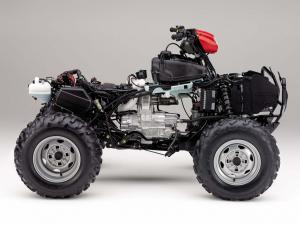
Braking
New, larger, dual hydraulic front disc brakes and a single rear drum make up the Foreman’s stopping package. Up front, the disc brakes were bumped up from a 180mm disc to 196mm. This change not only improves the Foreman’s stopping power, but is a better fit for those carrying the max capacity on the racks or pulling a full load of 850 pounds. Although many manufacturers have gone to rear disc brakes, Honda retained the Foreman’s sealed mechanical drum brake, however, we really appreciate that Honda retained the separate front-and-rear hand brake controls unlike some competitive machines. The larger front disc brakes worked well during our sporty rides through the trees and seemed more responsive than the rear drum.
Size & Ergos
The Foreman has a slightly larger feel to it and definitely a taller seat. Comparison photos show it being wider and taller than the Rubicon. Overall, the total changes have increased the Foreman’s weight by only two pounds, to 626 pounds. Weight has never really been a concern for Honda.
The new seat contributes to the ergonomics and blends well with the bodywork. We especially liked the tank cutouts that let riders hug the tank with their legs and sit comfortably. The seat’s shape and material have been changed as well, and height is about a half inch taller than previous models.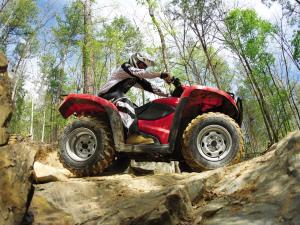
A new handlebar position was also added to the Foreman. In fact, Honda engineers targeted this Ride Triangle (handlebar to foot pegs to seat relationship) as one area to improve the machine’s comfort levels. “It’s primarily done through the raising the bars [around an inch]. Not only are they higher, but they are a little wider to give a more open feel,” explained Markofski. This goes for both a seated or standing position and it’s why Honda uses a special floorboard design.
“Every floorboard has a foot peg built in and that’s kind of unique to Honda,” Markofski explained. “It helps the rider maintain control. For example, when climbing it helps the rider rotate their feet. Instead of standing on a flat floorboard, you can move your feet and ankles for improved footing/leverage— nice!” We can verify this design is far superior for solid footing and control and we really wish other manufacturers would take note.
Two other key features found on the Foreman are the reverse lever and TraxLok differential lever. You can find reverse by compressing a small red “R” button by the parking brake on the left side of the bars. Once you do that, pull the lever and then shift down into reverse gear. To get out of gear, shift up and you’re on your way. It’s incredibly inconvenient for back and forth work like plowing snow, and when we asked the Rancher engineering team about this design a few years ago, they explained it was because the legal department wanted a three step process that never took the riders hands off the bars. What a pity! Regardless, once you do it a few times you’ll get the hang of it, and probably come to dislike it as much as we do. This system actually improves the shifting on just about every other brand.
We really like the cable-actuated 2WD/4WD TraxLok system however. The manual lever (located on the left side center section of the tank) comes straight from the Rancher and makes shifting in and out of 4x4 easy. It’s simple and it works every time!
Appearance
We like the new-look Foreman. It seems stouter and offers a refreshing appearance. Honda described the new facade as going from a sport-utility look to an aggressive-utility finish. We’re not quite sure what that means, but it must involve looking a bit tougher than in year’s past. In our opinion, it seems as though the new Foreman looks less like the Rubicon and more like an enhanced Rancher. This is not a bad thing, as the Rancher is a very popular model and has always delicately balanced both its utility and recreation aspects.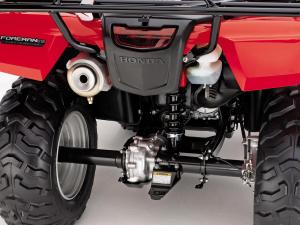
The refurbished Foreman also received improved mud-and-splash protection. The machine’s triple headlight configuration with single handlebar-mounted pod light was retained and is a feature we’ve always liked. Twin storage areas — one beneath the rear rack and another inside the left front fender —were also saved and are much appreciated. Tubular front and rear racks remain standard as does their weight capacities (66 pounds and 133 pounds, front and rear, respectively).
A new, waterproof, multi-function LCD digital meter was added to the Foreman. It includes readouts for fuel, gear position, speedometer, odometer, tripmeter, hourmeter and oil change reminder. Also included are LED lights for reverse, neutral, oil temperature and a front differential indicator.
The 2012 Foreman also features a few convenience items to cater to its hard-working owners. This includes a 12-volt DC outlet, no-tools air box with foam filter, tool kit, A-arm and CV boot guards as well as a large front bumper.
Models
Four models remain available in the Honda Foreman lineup and Honda assured us it’s what the customers and dealers want. It comes in either Honda Red or Olive Green. Honda’s exclusive Natural Gear camouflage is also available as a color choice and usually includes a $400 up charge.
Our test session only involved Foremans outfitted with Honda’s Electronic Shift Program (ESP). We like the system for the most part and understand it, but the selectable transmission on the Rancher AT would be a better fit in our opinion. We’d like the ability to choose between going fully automatic or shifting with ESP. With that said, we are extremely pleased that Honda has retained its foot-shift manual shift (with automatic clutch) Foreman models for those who don’t want or need ESP. There’s just something about foot shifting a 4x4 utility quad that takes us back to the early days of ATV riding.
According to Markofski, the foot-shift and ES models are equally popular. “People on the work side prefer both, depending on what their need is. For example, a farmer who uses a sprayer needs a hand free to operate the sprayer and the throttle, so he’s foot shifting,” he explained. “Then some guys work in real muddy conditions and say that the foot shift gets mucked up and clumsy so they prefer the Electric Shift Program.”
On the recreation side, Markofski stated that ESP lets riders keep the engine in its sweet spot. However, he also said there’s a need for foot-shift models for recreational riders. “In the Southeast, where it’s very wet, there are guys who will not ride anything but a foot shift machine and they want the most basic model.”
The New Foreman
The fifth generation Honda FourTrax Foreman builds on all that has worked on previous models and is basically an all new design. With four versions to pick from there is Foreman for every need whether on the farm or the trail and we’ll soon put one to work at both.
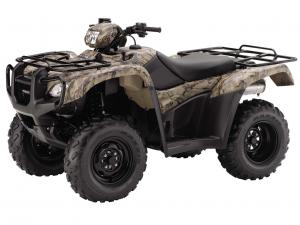 |
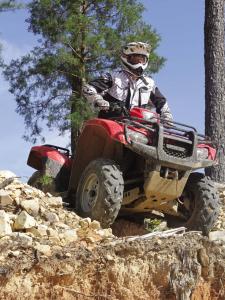 |
| ENGINE TYPE | 475cc liquid-cooled, longitudinally mounted, single-cylinder, four-stroke |
| INDUCTION | Keihin 36mm throttle body |
| STARTER | Electric with optional auxiliary recoil |
| CLUTCH | Automatic |
| TRANSMISSION | ESP five-speed with Reverse or Manual Five Speed with Reverse |
| DRIVELINE | Direct front and rear with TraxLok and torque-sensitive front differential |
| SUSPENSION | Front:Independent double-wishbone; 6.7 inches travel |
| Rear | Swingarm with single shock; 6.9 inches travel |
| BRAKES | Front:Dual hydraulic disc Rear:Sealed mechanical drum |
| TIRES | Front:25 x 8-12, Rear:25 x 10-12 |
| GROUND CLRNCE | 7.6 inches |
| FUEL CAPACITY | 4.0 gallons, including 1.2-gallon reserve |
| COLORS | Red, Olive, Natural Gear™ Camouflage |
| CURB WEIGHT* | 628 pounds / 644 pounds with all fluids - ready to ride |
| MSRP | Foreman FM $6,899 - Manual Shift |
| MSRP | Foreman FM EPS $7,499 - Manual Shift with Electronic Power Steering |
| MSRP | Foreman ES $7,099 - Electric Shift |








